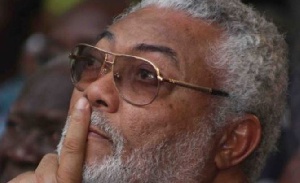 Former President Jerry John Rawlings
Former President Jerry John Rawlings
Former President Jerry John Rawlings on Monday issued a statement withdrawing comments he made about former Presidents John Kufuor and John Mahama.
The letter—a full-throated apology—is a rare instance of public contrition from the former President. Some have said the statement sounds insincere, some see it as embarrassing and others have wondered about the function or undergirding reason behind the statement.
Below is the full statement, textually analysed and annotated.
May 28, 2018
WITHDRAWAL OF COMMENTS ON FORMER PRESIDENTS
Comment on the Heading: The heading is clear, unambiguous and straight to the point. It signals his intentions. He doesn’t use the word “apology” but his intention is clear. The office of former President Jerry John Rawlings wishes to inform the general public that the former President has taken due note of concerns raised over certain publications arising out of a meeting he held with a delegation of chiefs and elders from Mepe in the Volta Region last Tuesday.
Comment: This statement is coming from the office of the former President. This is as official as it can get. He wasn’t prompted in an interview or pushed to respond. It is a heartfelt gesture purely based on his initiative. He addresses the public here, showing his sensitivity to public opinion, and then restates the occasion or circumstances under which the previous statement was said. So there is absolutely no intention to sound evasive.
The former President apologises to former Presidents John Agyekum Kufuor and John Dramani Mahama for the choice of words. He deems the words as inappropriate and withdraws them.
Comment: Is this a non-apology apology? No. Is it an apology of an apology? No. It is a full-throated apology. He mentions the two former Presidents by name and indicates his regret for the words used. In fact the word “apology” or “apologises” was used which is as sincere or as clear or as direct as one can get in acts of contrition. The sentence (containing the word “apologises”) is also presented in the active voice, showing personal commitment, rather in the passive voice which can sound ambiguous, non-committal and evasive.
CONCLUSION: This is definitely not a faux apology. It is a real apology; doesn’t sound formulaic or evasive. In fact former President Rawlings by this action, shows deference and respect to his colleague former presidents. He admits the act and takes responsibility—a mark of exemplary leadership. The timing seems quite right as it didn’t come too long after the initial comments. Under the theory of image restoration, the statement by Rawlings will fall under the principle of mortification, where individuals admit responsibility and directly apologise.
Within the context of our democracy, the statement fits into the concept of politeness theory where political actors either try to save face or avoid offense in political discourse. This tends to bring about civility and improve political communication within the public sphere. In addition, the statement should be seen as a turning point or an opportunity to actually improve relations between the former presidents as an example for healthy political relations, reconciliation and civility despite political differences. Perhaps getting a response from the former Presidents, though not expected, could further complete the process.